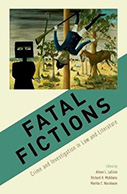Fatal Fictions; Crime And Investigations In Law And Literature

Editors: Alison L. LaCroix, Richard H. McAdams, and Martha C. Nussbaum
Publisher: New York: Oxford University Press, 2017. 344p.
Reviewer: Carolyn Naoroz | January 2018
Fatal Fictions is a compilation volume exploring themes of crime, criminal law, and investigations throughout a variety of fiction. Texts analyzed range from criminal law processes and precedents evident in the ancient Greek tragedies and the Talmud, to categories of crimes, investigations, and motives in Shakespearean and Tudor Era literature, ending with science fiction and crimes against humanity in Twentieth Century. Arranging essays on such a wide range of fiction is no easy feat, particularly when it comes to organizing the work of scholars from disparate disciplines into an engaging order from which common themes can be found. The editors’ choice in this volume was to arrange the chapters in chronological order of the time period within which the work of fiction was set, as well as within section categories of criminal histories, race and crime, responsibility and violence, and suspicion and investigation. Fatal Fictions begins with an analysis of the Greek play of Eumenides, flows through Tudor Era England that includes the works of Shakespeare and historical fiction author Hillary Mantel, to more recent works set in Twentieth Century South Africa, as well as a work of fiction set within a future society.
The editors note three main points on the interplay between crime and fiction for the readers to consider as they work their way through the collection of essays. First, the editors highlight the fact that crime and criminal justice processes are inherently political, as how crimes are legally defined and processed through the criminal justice system is in itself a political process that often reflects the changing morals and values of society. Second, the editors state that crime is highly psychological and therefore ripe for works of fiction to explore the human psyche in regards to criminal motive and victim reaction. Third, the act of committing a crime is inherently dramatic due to the high-stakes of life and death conflict that often accompany a criminal act. The same can be said of the trial process where defense lawyers must fight for the rights of their clients, prosecutors must defend the innocent as well as the state, and a jury comprised of everyday individuals must decide the fate of the defendant. To a modern media consuming audience, these themes are already inculcated into reading and viewing habits evident in the popularity of crime-based novels, films, and TV shows. Thus, LaCroix, McAdams, and Nussbaum easily make the case for an academic text exploring these themes across a wide array of literary works.
What is more difficult to connect throughout Fatal Fictions is the editors’ assertion that their volume is connected to more pressing themes facing crime and justice scholars today, such as the long, drawn out foreign conflicts of the War on Terror, the militarization of police, and mass incarceration. While these issues are highly relevant to criminological scholars and broader society, the essays in Fatal Fictions do not truly explore these themes. A different literary collection would need to be compiled to explore the themes of racism, xenophobia, and violence of the state inherent in foreign conflicts, policing culture, and incarceration policies of modern times. The only chapters that explore similar themes are those by Driver and Nussbaum that explore themes of racism, violence of the state in the Court of Henry VIII as analyzed by LaCroix, and the gender dynamics present in the Talmud as touched on by Wimpfheimer. Therefore, while the editors did a fine job organizing the volume both chronologically as well as into themes, they fell short of addressing the current social issues mentioned in their introduction. The book is perfectly fine on its own merits and does not require the justification of attempting to tie the material to current hot topic issues.
In essence, Fatal Fictions is a well-intentioned volume with some very strong chapters, most notably those written by LaCroix, Foa, and Nussbaum. The essays provide strong analysis of the texts chosen, and the book as a whole is perfectly suited to those readers who seek to critically analyze works of fiction. What Fatal Fictions suffers from most is the abrupt change from the legal scholar voice to the scholarly voice of classics and philosophy scholars. While the inclusion of a broader range of academic disciplines should be a strengthening point of the book, those chapters not written by legal scholars are disruptive to the legal and criminological reader, as the concepts of these disparate disciplines do not share foundational scholars and texts that create a common shared academic language. The chapters written by classics and philosophy scholars have merit and are beautifully written but these chapters are better suited for an audience of their students and peers, not necessarily those audiences interested in crime and law.
The largest section of Fatal Fictions is on criminal histories, including several works of fiction set during the Tudor Era of England. Although not stated, the bulk of essays most likely centered on works from and based in this Anglo time period due to it being integral to the foundation of common law used both in England and America, as well as the familiarity of Shakespeare to a Western audience. This is not to say that Fatal Fictions does not include literature from other cultures, merely that it is important to note that American legal processes share a common origin with England’s, thus engendering a communal literary history. The particular standouts of this section were the essays written by LaCroix and Foa.
Editor LaCroix’s chapter, “A Man for all Treasons”, centers on the historical fiction works of Hillary Mantel, Wolf Hall and Bring Up the Bodies, that follow the career of Thomas Cromwell in the court of Henry VIII. The themes of crimes of and against the state are explored, as are the investigative techniques Mantel has Cromwell employ. LaCroix argues that Cromwell represents both crimes of the state and those committed against the state as he straddles the two types of power presiding in England at that time: the power of the King, or executive, and the power of Parliament. As LaCroix aptly notes, Cromwell utilizes his knowledge of these two branches of power to achieve what he thinks is best for England, as well as what is best for himself. The crime of state committed by Cromwell, and nearly everyone in the court of Henry VIII, is that of espionage. Espionage is inextricably linked to crimes against the state in the form of treason, as the gathering of information was intended to expose treasonous individuals. To think of the King’s death, let alone to speak of it, was treason in Tudor times. This definition of treason sounds very foreign to modern, Western ears who regularly assert their First Amendment right to free speech. Yet, in the Tudor Era, speaking of the King’s death could quickly land a person with their head on the chopping block, let alone the hanging, drawing, and quartering that would occur if someone took action against the State. These were violent times, and LaCroix captures both the mental prowess of Cromwell in her analysis, as well as his brutal ruthlessness.
In the chapter “What’s Love Got to Do With It?”, Foa provides a delightful prosecutorial analysis of Shakespeare’s Measure for Measure, with particular emphasis on exploring the Duke of Vienna’s motives to leave the law enforcement of Vienna to the supposedly incorruptible and morally strict Lord Angelo. As Foa asserts, Measure for Measure ultimately serves as an example of how power corrupts. This is displayed in how the Duke of Vienna feels entitled to marry whomever he wishes, even if the bride of his choice is a woman who desires to enter a convent, as is the case with the character of Isabella. Lord Angelo also allows power to corrupt him, moving to immediately enforce the morality laws of Vienna which becomes the impetus for all the action of the play and how the Duke of Vienna traps Isabella into marriage. While the Duke of Vienna appears to take a hands-off approach to ruling his people and achieving his personal goals by pretending to travel from Vienna, he is actually taking stronger control by allowing Viennese law to intervene in the personal lives of the population in order to achieve his own ends. Therefore, the Duke of Vienna’s motive appears to mostly be driven by self-interest for a woman who would not marry him unless morally disqualified from becoming a nun. As Foa states, Measure for Measure could also serve as an example of the virtues of lax enforcement policies, as strict enforcement of the morality laws was a disruption in the lives of all the characters.
Fatal Fiction’s section on race and crime is comprised of two chapters, notably one chapter analyzing Cry, the Beloved Country by Nussbaum. Cry, the Beloved Country is a novel of two South African fathers who turn away from anger and blame after the son of the black father murders the son of the white father. Nussbaum explores the themes of peace and forgiveness in achieving a mutually cooperative interracial future that are present within the novel. Instead of the common opinion that public atonement and anger are necessary for change, Nussbaum argues that Paton’s work espouses mutual respect and generosity without anger or public atonement as a way forward to peace. Published in 1948, the themes of racial inequality in Cry, the Beloved Country were made concrete with the codification of racial stratification and discrimination within South African apartheid, yet the overarching themes of mutual respect and generosity are found in the work of Nelson Mandela who was instrumental in finally ending apartheid in the 1990’s. Of all fifteen chapters, Nussbaum’s chapter most clearly provides a recommendation for overcoming systemic racial tension that could apply in current times.
In sum, Fatal Fictions may prove to be interesting and useful to scholars of media representations of crime and the criminal justice system, and to those readers who wish to critically analyze fictional texts. The essays were enlightening and the editors organized the broad ranging topics into coherent groupings. A book of this nature does not require the justification of connecting the material to current events to solidify its purpose. In fact, the attempt to tie in themes of international conflicts, the militarization of police, and mass incarceration in the introduction sets up the reader to expect something that is not delivered. The fictional texts chosen for analysis do not address these topics but are interesting and groundbreaking in their own right, as is the analysis each author presented, which is all the justification Fatal Fictions needs.
Carolyn Naoroz, Doctoral Candidate, Virginia Commonwealth University


